#poverty row
Text


Vintage Poster - The Gorilla
20th Century Fox (1939)
#Posters#Film#Gorilla#The Gorilla#Ritz Brothers#Gorillas#Horror#Humor#Art#Vintage#Patsy Kelly#Bela Lugosi#Lionel Atwill#The Ritz Brothers#Poverty Row#20th Century Fox#1939#1930s#30s
28 notes
·
View notes
Text

Poverty Row
15 notes
·
View notes
Text

On Poverty Row in Hollywood circa 1926, California Studios and Bischoff, Inc., the home of H.C. Witwer Comedies, Biff Thrill Comedies, and Gold Medal Comedies. Located on Gower St. just south of Sunset Blvd.
20 notes
·
View notes
Text
On April 20, 1946, The Catman of Paris debuted in the United States.

Here's some new art inspired by the horror classic!
#the catman of paris#lesley selander#poverty row#b movie#horror movies#horror film#horror art#horror#mystery film#1940s#1940s film#1940s horror#jeepers creepers theater#movies#film#classic film#classic horror#movie art#art#drawing#movie history#pop art#modern art#pop surrealism#cult movies#portrait#cult film
2 notes
·
View notes
Text
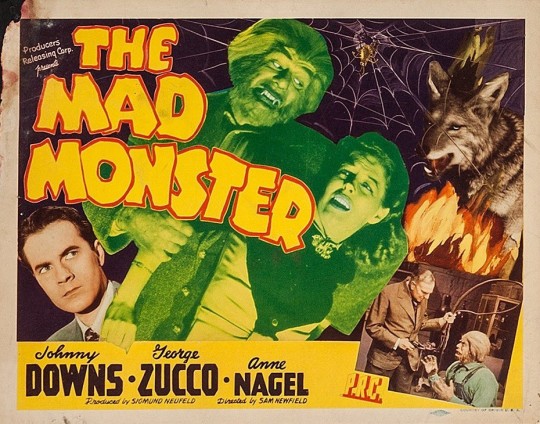
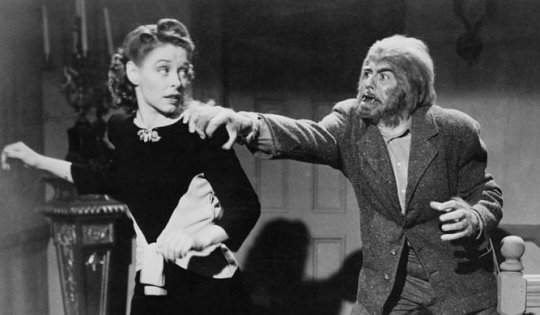
Continuing my October reviews.
The Mad Monster (1942) is one of those pesky little poverty row horror films that had the potential to be so much better. The cast of George Zucco, Glenn Strange, and Anne Nagel are top notch for poverty row. OK, top billed Johnny Downs is pretty weak but still, there's a lot to work with here. We had great spooky swampy sets. We had Anne Nagel, as pretty as pretty gets. And we had George Zucco just as evil as evil can be. But other than a few scenes, it just doesn't work. Sam Newfield's direction is all over the place with awkward and embarrassing scenes (see the woods scene with the villagers all turning to face the camera) followed by fairly good action scenes like the climax. Still worth the effort if you can find it if nothing else to say that you've seen Glenn Strange play a werewolf.
31 notes
·
View notes
Text
El primer zombi suelto en Hollywood
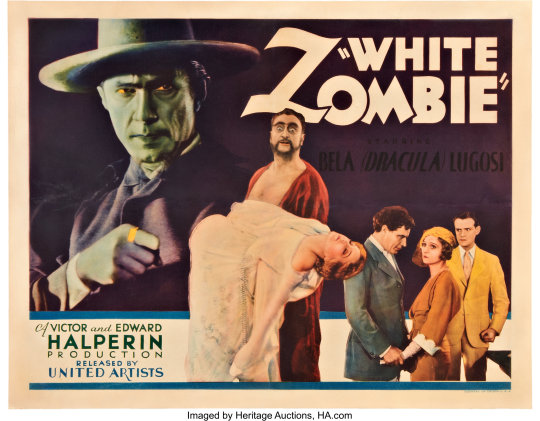
Por Gonzalo Jiménez
Los zombis, tal como los conocemos, son una creación de George A. Romero. Ese es el canon que, de alguna manera, ha imperado en Hollywood desde que Romero dirigiera en 1968 La noche de los muertos vivientes. Los zombis en Romero no guardan relación con el mito haitiano, salvo en el detalle de que son muertos reanimados; pero su origen es la radiación de un satélite que cayó del espacio.
El zombi ya posee entidad como uno de los monstruos clásicos del cine; hasta puede hablarse de un género de películas. Los muchos fanáticos de los filmes y series de TV sobre zombis ignoran cuál fue el primer gran éxito que el tema tuvo en Hollywood: un largometraje que había sido olvidado durante décadas hasta que la TV lo rescató en los años 60 y volvió a ser apreciado por una nueva generación. Esta es la historia de ese filme, White Zombie (La legión de los hombres sin alma, 1932).
Parte de la razón para que White Zombie no tuviera el estatus de otros clásicos del cine de horror como Drácula o Frankenstein (ambas de 1931) es que White Zombie es un filme independiente, financiado por un pequeño estudio de cine, Halperin Productions, que formaba parte de la llamada Poverty Row, que era como se designaba a los estudios menores que operaban independientemente en Hollywood, como Monogram, Majestic, Mascot y Puritan, entre muchos otros, que ya no existen y pocos recuerdan ya.
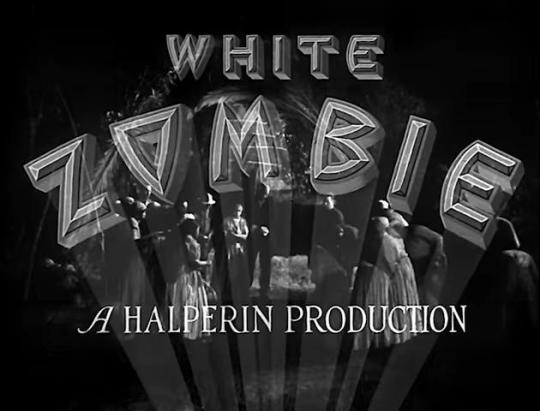
Según indica el libro Forgotten Horrors (Midnight Marquee Press. Baltimore, 1999), de George Turner y Michael Price, la palabra “zombie” fue introducida ante grandes audiencias en Estados Unidos con el libro sobre vudú haitiano The Magic Island, de William Seabrook. El concepto luego llegó al teatro, con la obra Zombie, que produjo Kenneth Webb en Nueva York y se estrenó en febrero de 1931. Sólo se ofrecieron 21 funciones de esa pieza. Curiosamente, Webb amenazó con demandar en marzo de ese año a los productores Edward y Víctor Halperin cuando estos anunciaron que iniciarían el rodaje de una película llamada White Zombie.
La historia de los hermanos Halperin es singular. Ambos arribaron a Hollywood a comienzos de la década de 1920. Tenían formación universitaria e inclinaciones por el teatro. Juntos produjeron una docena de películas mudas para los estudios First National, United Artists y Vitagraph; casi todas melodramas. Nada presagiaba que les interesaría incursionar en el género del cine de terror.
Los hermanos tenían una obsesión: encontrar una aproximación científica a la forma de hacer cine. En pocas palabras, teorizaban sobre hallar una fórmula que garantizara en 100% el éxito de una película. Sus análisis de filmes exitosos los condujo a preguntarse por qué funcionaban en la taquilla Drácula (Universal) o Dr. Jekyll y Mr. Hyde (Paramount). Los Halperin (Víctor siempre dirigió y Edward era el productor) concluyeron que los diálogos debían limitarse al 15% del filme y que el resto debía ser pura acción.

Esta aproximación a la trama también se reflejó en su manera de hacer cine. White Zombie se completó en apenas 11 días de rodaje. Víctor Halperin y Garnett Weston escribieron el guión, con la asesoría del sargento Faustin Wirkus, otrora administrador de la isla de La Gonave, frente a Haití. El presupuesto fue de 65.000 dólares, aportados por la empresa Amusement Securities Corp. y por el productor independiente Phil Goldstone. Y como estrellas del filme se contrataron a Madge Bellamy (actriz del cine mudo que anhelaba un regreso triunfal) y Bela Lugosi, fresco del éxito de taquilla obtenido en Drácula y Murders of the Rue Morgue. En algunos libros se indica que Bela Lugosi sólo recibió 800 dólares como pago por White Zombie (en el libro Forgotten Horrors se indica que fueron 500 dólares por una semana de trabajo), pero cuesta creer que, si bien era una producción independiente, el actor húngaro se tranzara por esa cifra. Madge Bellamy, por ejemplo, comentó que le pagaron 5.000 dólares por su papel, que es estrictamente secundario frente al de Lugosi.
Lo cierto es que White Zombie en absoluto luce como una película barata. Sin duda, los diálogos y ciertos aspectos de la trama han envejecido mal. Pero todavía sorprende la dirección de fotografía de Arthur Martinelli (de lejos, lo mejor de la película). El filme se rodó en los escenarios de los estudios Universal, por lo que los hermanos Halperin le sacaron provecho a los decorados de primer nivel de la empresa; el director de arte fue Ralph Berger, quien comisionó a la empresa Howard Anderson Co. para hacer los efectos especiales y los trucos de cámara, que simulaban escenarios inmensos. Por ejemplo, el interior del castillo de Murder Legendre (Lugosi) fue usado en Drácula y en El jorobado de Nuestra Señora de París.
Jack Pierce, creador del legendario maquillaje de la criatura de Frankenstein, hizo el maquillaje de los zombis en la película, así como del personaje de Bela Lugosi, Murder Legendre. Lugosi creó con Legendre uno de sus villanos más memorables. No sólo era una cuestión de maquillaje; ayudó también los acercamientos que la cámara hacía de su rostro. Legendre crea zombis a través de la magia negra para valerse de mano de obra que trabaje sin parar en su molino de caña. Pero los zombis a los que hace alusión el título del filme son seis hombres blancos, que fueron enemigos de Legendre y éste los transformó en muertos vivientes: Latour, el brujo antiguo mentor de Legendre; Von Gelder, un terrateniente adinerado; Víctor Trischer, ministro del Interior; Scarpia, oficial del ejército; Marquis, capitán de la policía; y Chauvin, el verdugo de la isla.
White Zombie, pese a sus limitaciones, probó ser un éxito en la taquilla y eventualmente, con el paso del tiempo, encontró defensores en los espacios menos esperados, como en el del músico (y ahora cineasta) Rob Zombie, quien bautizó a su primera banda con el título del filme. En YouTube es posible ver la película completa. Una curiosidad, para quienes son fanáticos del género de horror.
(Publicado originalmente el 11 de diciembre de 2012 en el blog de los Hermanos Chang).
3 notes
·
View notes
Text
Billy the Kid in Texas (1940)
Billy the Kid in Texas (1940) - Lydia and Christopher saddle up for the first time in a while to check out a listener requested western. #PodNation #PublicDomain #Western #BillyTheKid #Podcast #Podcasting
Lydia and Christopher saddle up for the first time in a while to check out a listener requested western.
Promo: Bottom of the Stream Podcast (https://bottomofthestream.podbean.com/)
Please click, follow, rate and review!
https://linktr.ee/TSPandOE_Podcasts

View On WordPress
0 notes
Text
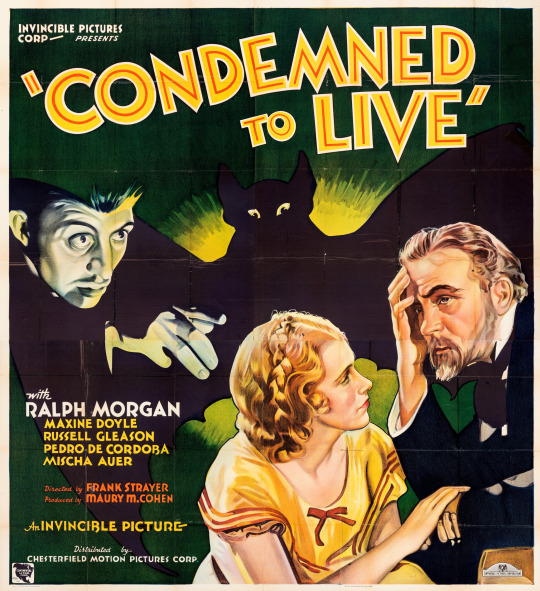
Condemned to Live (1935)
#condemned to live#ralph morgan#maxine doyle#russell gleason#pedro de gordora#mischa auer#1935#1930s movies#1930s horror#frank r. strayer#poverty row hollywood#horror movie poster
47 notes
·
View notes
Text
If your girlfriend didn't fight with your father for your right to wear women's clothes, why do you need such a girlfriend at all

They

#I found an unknown fandom and an unknown OTP and I live for it#I cried in the arch with the appearance of Ringo in the manga#I do not know why but this moment finished me off#And then I drew it for 8 hours in a row because of hyperfixation#And then I cried again over these episodes in the anime#Ranmaru Rindou#Ichiko Sakura#binbougami ga!#The god of poverty is#Good luck girl
35 notes
·
View notes
Text
I'm going to start a Youtube channel based entirely on rage bait thumbnails. Instead of being "angry shoe guy" or "angry tech guy" or whatever, I'll just be "angry contrarian guy." Here are a few of my future video titles:
- SAINTS ROW 2 RUINED SAINTS ROW!
- SHAME ON OLIVE GARDEN! UNLIMITED BREADSTICKS NOT UNLIMITED!
- SOUTHERN POVERTY LAW CENTER GOES WOKE!
- BORDERLANDS THE MOVIE IS A CINEMA MASTERPIECE!
- DRAKE REALLY WON THE BEEF WITH KENDRICK LAMAR!
4 notes
·
View notes
Text

By: Ian Rowe
Published: Sep 14, 2023
Imagine you are twelve years old and your public-school teacher asks you and your seventh-grade classmates to stand side by side in a line. The instructor lists a series of personal attributes and says that you must take an action based on your alignment with a particular attribute, to demonstrate either your privilege or your disenfranchisement:
“If you are white, take two steps forward. If you’re a person of color with dark skin, take two steps back. If you’re black, take two steps back.”
This exercise, part of what is called a Colorism Privilege Walk, actually occurred at public schools in Evanston, Ill., and at many other schools across the country. According to the lesson plan, the goal was for white students to “learn more about white privilege, internalized dominance, microaggressions and how to act as an ally for students of color.” In other words, the point was to reveal the real sources of a person’s privilege: the unearned benefit of being white over the intrinsic victimhood of being nonwhite.
Because of these student Privilege Walks, and since the district had also conducted professional-development sessions that divided teachers by race, an Evanston teacher and the Southeastern Legal Foundation filed a lawsuit accusing Evanston School District 65 of violating the 14th Amendment’s equal-protection clause and Title VI’s prohibition on discrimination at federally funded educational institutions.
In all likelihood, these racially divisive practices in Evanston will be found legally impermissible — especially given the Supreme Court’s decision deeming race-based affirmative action unconstitutional in college admissions. Yet across a country now transfixed by the pursuit of equity, there is an obsession with determining what factors drive economic inequality and whether a person is inherently privileged or inherently oppressed based on a single characteristic, most notably race.
Against this backdrop, enter economist Melissa Kearney, who has done America a great service by publishing The Two-Parent Privilege. Kearney unequivocally states: “Marriage is the most reliable institution for delivering a high level of resources and long-term stability to children. There is simply not currently a robust, widespread alternative to marriage in US society.” In terms of benefits to children, not all family configurations are the same. Throughout the book, Kearney posits the necessary caveat that no person should remain in an unhealthy or violent marriage, but she makes plain the case that a married, two-parent household is generally superior to alternative arrangements such as cohabitation and single parenthood.
Rather than resort to making a moral or religious argument for marriage, Kearney, an MIT-trained economist, is determined to “bring the social science evidence on family structure from the obscurity of academic journals into the public conversation.”
Kearney simply sticks to the facts and makes an overwhelming data-based case that marriage and stable two-parent families matter monumentally to the life prospects of children — far more than the usually invoked suspects of race and gender. According to Kearney, in 2019, “77% of white children and 88% of Asian children lived with married parents. The share among Hispanic children was 62%. Only 38% of black children live with married parents — a historically low share that reflects a downward trend over four decades.” With such huge differences in family structure by race, how can one not fairly conclude that family-structure disparity is the greatest driving force behind racial disparities in education, crime, and virtually every area of concern for kids growing into young adulthood?
Indeed, Kearney surgically lays out the new dividing line in America’s quest for upward mobility:
There has been a massive widening of the family gap, such that a two-parent family has become yet another advantage in life enjoyed disproportionately by the college-educated class. The decline in the two-parent family among parents without a four-year college degree is a demographic trend that should concern anyone who cares about the well-being of children and about widespread economic opportunity, inequality, and social mobility in America.
One can only hope that during this election season presidential contenders emphasize how crucial healthy marriages and two-parent households are as the foundation for achieving virtually every social or economic policy objective. They would be wise to follow several of the policy recommendations in Kearney’s book, including, most notably, improving the economic position of non-college-educated men so that they are more reliable marriage partners and fathers. But Kearney recognizes that policy alone will not solve the problem. She strongly argues for a cultural shift that fosters a norm of two-parent homes, in part by simply being open and “honest about the benefits that a two-parent family home confers” on children.
In reviewing Kearney’s prescription, my only wish is that she had spent more time in two areas: (1) advocating that marriage and family structure become a standard data category through which child outcomes are analyzed, especially in education; and (2) identifying strategies to engage the rising generation to think differently about their decisions when it comes to the timing of their own family formation.
In regard to the former, the National Assessment for Educational Progress (a.k.a. the Nation’s Report Card) reports reams of educational data disaggregated by race, gender, geography, and other usual-suspect categories. But family structure is not one of them, despite the paramount role that marriage plays in influencing achievement gaps.
Including family structure could create opportunities to implement different types of interventions that could improve life outcomes for the next generation. For example, at Vertex Partnership Academies, the virtues-based high school I launched in the Bronx in 2022, in a class called Pathways to Power we teach the data associated with the “success sequence.” This is research that shows that the vast majority of young adults who graduate from high school, get full-time jobs, and marry before having children reach the middle class by their early 30s. Young people deserve to know this information, especially when they live in environments where most neighboring families have not followed that sequence.
* * *
In May 2001, writing for National Journal, Jonathan Rauch noted that, “according to Census Bureau data, a two-parent black household is more likely to be poor than is a two-parent white household, but both are far less likely to be poor than is a mother-only household of either race. In other words, if you are a baby about to be born, your best odds are to choose married black parents over unmarried white ones.”
Rauch was highlighting then what Kearney so effectively illustrates now, that in economic terms a parent’s marital status has displaced race and class as a primary driver of child poverty and upward mobility.
And perhaps this message is finally getting through. For evidence, look no further than a four-minute video titled “If someone doesn’t understand privilege, show them this.” Across Facebook, YouTube, Twitter, and several media platforms, it has been viewed more than a staggering 125 million times. It captures another Privilege Walk, but in this case the personal attributes being presented are markedly different from those posed in Evanston.
The first two directives are: “Take two steps forward if both of your parents are still married. Take two steps forward if you grew up with a father figure in the home.”
In Kearney’s final chapter, she warns that “if millions of American children miss out on the benefits that come from a two-parent home and if the family gap continues to widen” then “children will suffer, inequality will continue to widen, and social mobility will erode.” It does not have to be this way. If we are brutally honest in accepting Kearney’s analysis of what truly privileges children, we know what the next steps forward should be.
[ Via: https://archive.md/F4YE8 ]
--

[ Source: Wikipedia ]

[ Source: Mother Jones ]
==
Stop blaming things on "systemic" -isms. There are often known or contributing factors at play, and refusing to acknowledge or address them is dishonest, not virtuous. It identifies nothing, solves nothing, and only serves to make people feel powerless, who are not actually powerless. Although, perhaps that's the point.
Where two-parent households are not possible, it should always default to joint/shared custody, rather than sole custody, with sole only as a last resort when unavoidable.
Joint custody should be the rule, not the exception
Children Likely to Be Better Adjusted in Joint vs Sole Custody Arrangements in Most Cases, According to Review of Research
The Consequences of Fatherlessness
#Ian Rowe#Melissa Kearney#systemic racism#fatherlessness#poverty#family structure#two parents#two parent homes#two parent family#social science#two parent privilege#religion is a mental illness
13 notes
·
View notes
Text


youtube
On the Late Late Show: House of Mystery (1934)
9 notes
·
View notes
Text

Row row row your boat
#Row row row your boat#comics#comic#cartoons#cartoon#memes#meme#budget cuts#budget#neoliberal capitalism#capitalism#capitalist hell#ausgov#politas#auspol#tasgov#taspol#australia#fuck neoliberals#anthony albanese#albanese government#anti capitalist#washington capitals#capitalist dystopia#capitalist bullshit#eat the rich#eat the fucking rich#class war#poverty#homeless
4 notes
·
View notes
Text
On July 4, 1964, Bowery at Midnight was screened on Jeepers Creepers Theater.


#jeepers creepers theater#bowery at midnight#wallace fox#bela lugosi#monogram pictures#poverty row#horror art#horror movies#horror film#horror thriller#horror#1940s horror#1940s film#1940s cinema#black and white film#black and white art#midnight movies#movie art#art#drawing#movie history#pop art#modern art#pop surrealism#cult movies#portrait#cult film
2 notes
·
View notes
Text


Fog Island (1945) is listed as one of the better Poverty Row horror films, so I gave it a look after finding a really bad copy streaming on Amazon Prime. This PRC film is really an "old dark house" story and is silly and boring for most it's run, but there is some neatly horrific stuff at the end. It stars both George Zucco and Lionell Atwill, so worth a look for that at least. Recommended if you (like me) feel the need to explore poorly written, half produced, and unimaginatively directed films from Poverty Row.
24 notes
·
View notes
Link
By Stephen Millies
Richard “Alex” Murdaugh was convicted on March 2 of murdering his spouse and youngest son. Those are horrible crimes. So why didn’t the South Carolina prosecutor demand the death penalty for the wealthy white lawyer instead of seeking a life sentence for Murdaugh? It isn’t as if the Palmetto State has been shy about inflicting capital punishment.
Capital punishment in the United States was aptly described by John Arthur Spenkelink, who was electrocuted in Florida in 1979. He said, “Them without the capital get the punishment.”
#Alex Murdaugh#death penalty#execution#racism#class struggle#workers#poverty#South Carolina#ruling class#capitalism#death row#prisoners#Struggle La Lucha
18 notes
·
View notes